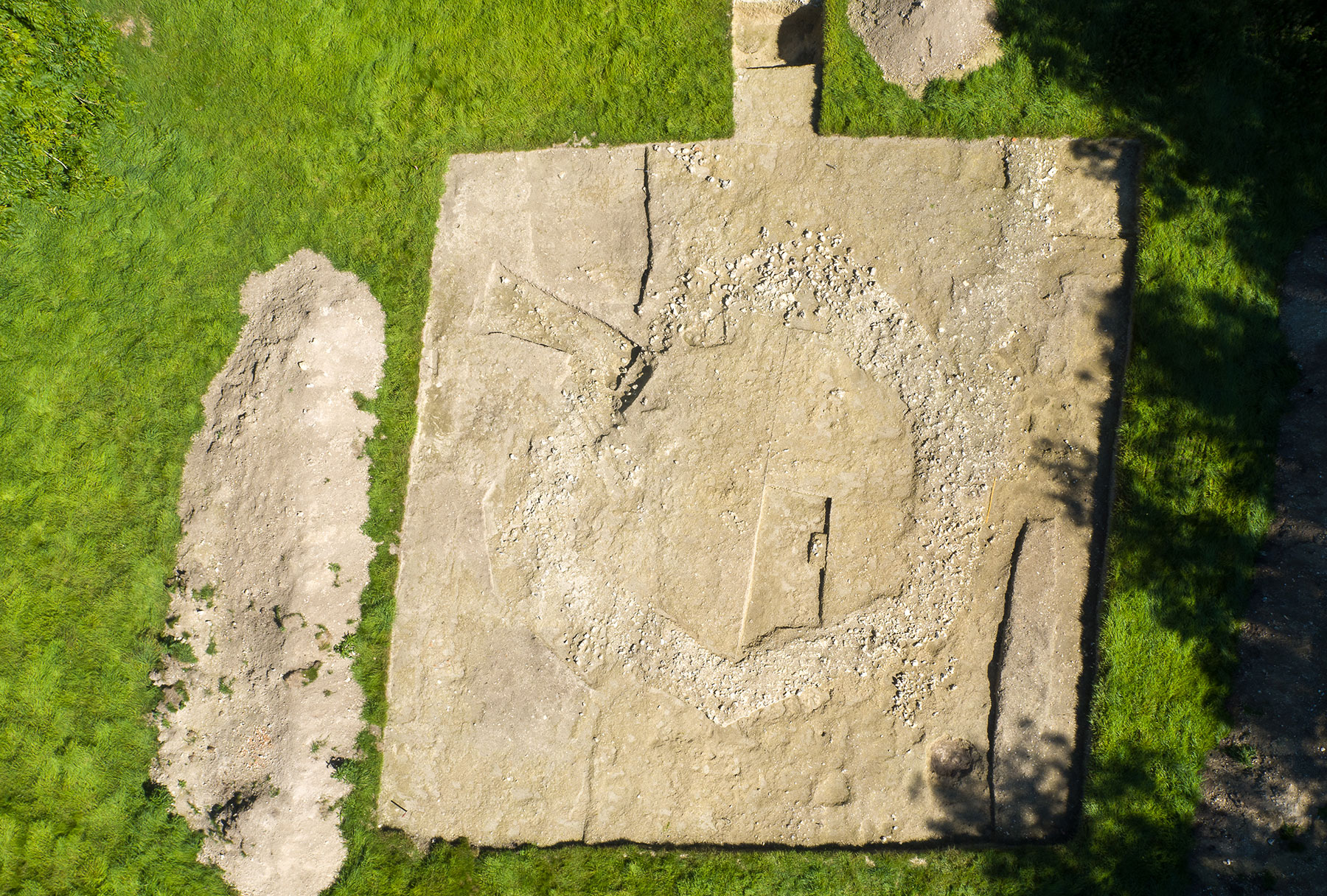Meonstoke Roman Excavation Project
Investigating a unique hexagonal temple site in the Meon valley near Winchester

About the Meonstoke project
Site history
Knowledge of a Roman building on the outskirts of Meonstoke, east of Winchester in the Meon valley, goes back to the 1930s, when widening of the main road up the Meon Valley, now the A 32, resulted in the discovery of Roman foundations in the roadside ditch. When investigations started in earnest in the 1980s, the old findings were put in context, and established to be part of an aisled building that had been cut across by the main road. Excavations from 1984 to 1991 concentrated on this building, and revealed a very well preserved collapsed wall, which had originally been the short end of the aisled building. This enabled us to propose a detailed reconstruction of the appearance of this type of architecture. The façade, which can now be seen in the British Museum, was elaborate and had two sets of arcaded openings, above an arched entrance, all laid out in Roman feet. The building would have been large, up to 40 Roman feet high, 50 feet wide and 100 feet long.
In recent years, the research aims of the Meon Valley project moved on to the Anglo-Saxon period. Excavation of an Anglo-Saxon cemetery was followed up by geophysics, conducted by the Meon Valley Archaeology and Heritage Group under the direction of Dr Nick Stoodley and Dr Andy Payne. By 2015, these had yielded detailed results for the field belonging to Manor Farm, Exton, on the west side of the A 32. The end of the aisled building was located, as expected, but it was badly damaged by a historical badger sett. A few metres further west, a row of rooms could be seen, possibly a bath house. Next to this building a separate hexagonal trace could clearly be seen.
Hexagons are rare in Roman architecture, the most famous being the large hexagonal harbour of Trajanic date at Portus at the mouth of the River Tiber. In Britain they are known at another Hampshire villa site, Dunkirt Barn, Abbotts Ann, near Andover, and at the temple site of Colleyweston Great Wood, Rutland. A ditched hexagonal cemetery enclosure is also known from Kent, near Canterbury. Octagonal or circular buildings are much more common, found at several villa sites and usually interpreted as agricultural outbuildings. Octagonal shrines are also relatively more numerous than an hexagonal temple.
Photo: a drone's eye view of the hexagonal temple at Meonstoke
Current investigations
The unusual hexagonal outline at Meonstoke became a natural focus for renewed excavation work at the site, which commenced in 2016. Finds associated with the hexagon were few, but included second-century samian ware, third and fourth-century Alice Holt and New Forest wares and a small assemblage of early to mid fourth-century bronze coins, almost exclusively House of Constantine. It is likely that the hexagonal building was contemporary with the aisled building, the floruit of which was late third century to mid-fourth century.
An unusual find, chronologically, was a Late Iron Age silver minim of Epaticcus, dated to the decade or so just before the Roman conquest. This opened the possibility of an Iron Age phase to the site’s sequence. This hypothesis was strengthened by excavation of a small pit, to the south of the hexagon, and within the courtyard. The pit contained structured deposits; three broken and abraded complete pots, a horse scapula and rib, and selected worked flint nodules that had been selected for white, black/dark grey and dark red colouration. The pottery had its best parallels in the early post-Roman conquest phases at Silchester.
During the 2018 excavation season, a horse and foal burial emerged from the excavation in the centre of the hexagon. This Late Iron Age deliberate burial was found underneath the later Roman hexagonal shrine. The adult appears to be a small young mare, while the foal is new-born and was laid beside the mare facing the opposite direction.
Ritual?
The presence of a pit with a structured deposit, together with other concentrations of animal bones (chiefly sheep or goat) in specific groups, raises a strong possibility that the hexagon had a ritual purpose, and was the latest phase of a sequence of such activity at the site. The questions therefore arise: was the hexagon a shrine, and the aisled building part of a religious complex rather than a villa? Was this why no main villa building has been detected so far?
Community engagement
The project is a collaboration with the Meon Valley Heritage and Archaeology Group, and is run as a community project on their behalf.
Open Days and site tours
On 19 July, Prof. King led an evening tour of the site for the Hampshire Field Club and Archaeology Society. Following the successful Open Day in July 2017, the 2018 Open Day took place on 21 July.
Talks
Prof. King gave a talk on the excavation to Droxford Historical Society on 26 July 2018.
Research team
- Principal Investigator: Prof. Tony King, Professor of Roman Archaeology and University of Winchester Emeritus Professor.
- Co-Investigator: Dr Nick Stoodley, Visiting Research Fellow
Meonstoke in the media
Acknowledgements
We are very grateful to the farmer and landowners Mr and Mrs Martin, for their enthusiastic support and permission to excavate.
The workforce for the excavation was provided by volunteers of the Meon Valley Archaeology and Heritage Group and students from the University of Winchester.
Financial assistance was received in the form of grants from the Association for Roman Archaeology and the University of Winchester.
We are also grateful for help and advice from the South Downs National Park Authority and the archaeological staff of Hampshire County Council.
The finds and archive from the excavation will be deposited with Hampshire Cultural Trust, Chilcomb House, Winchester.
Literature
King, A. C. 1996 The south-east façade of Meonstoke aisled building, in P. Johnson and I. Haynes (ed.), Architecture in Roman Britain, York: CBA Research Report 94, 56-69.
